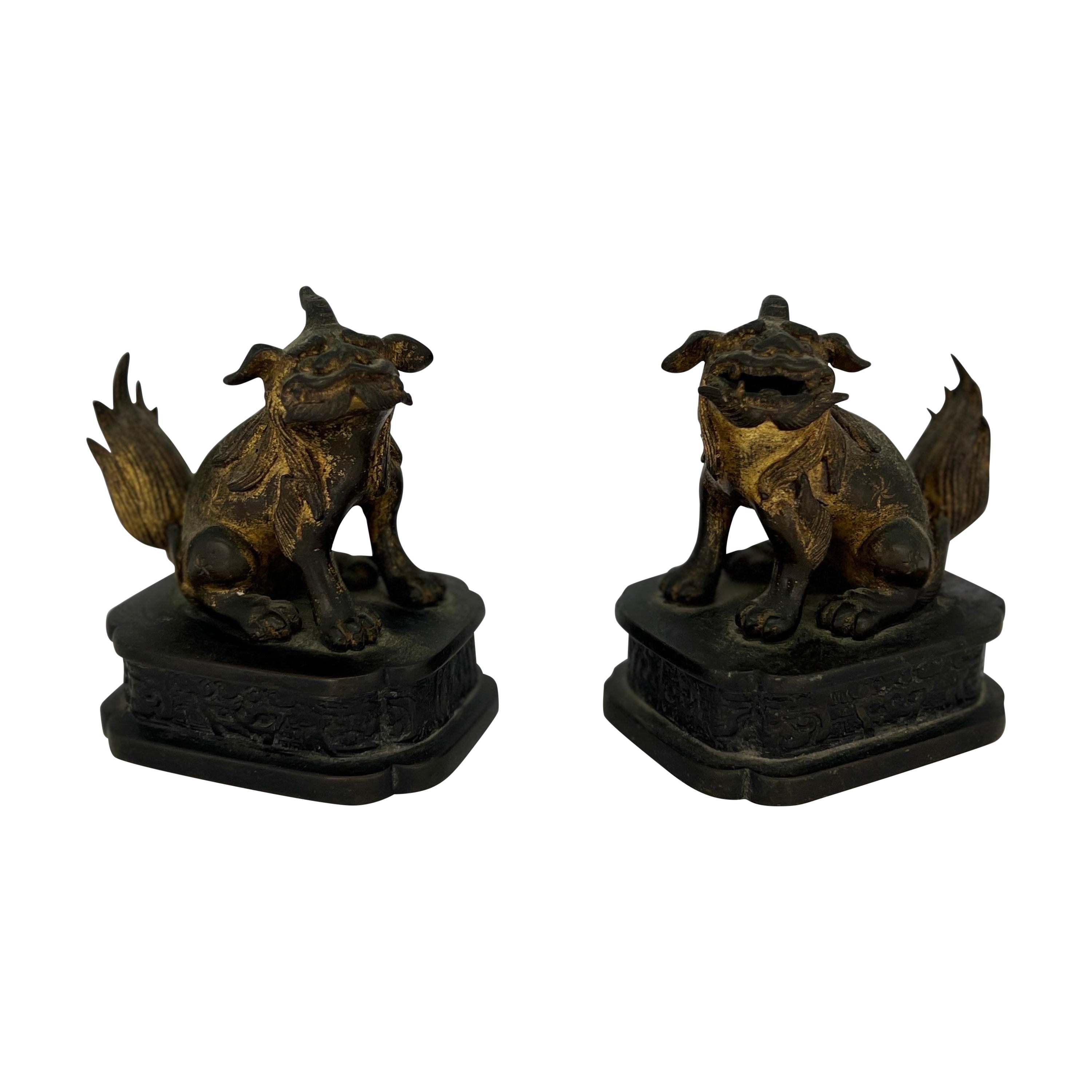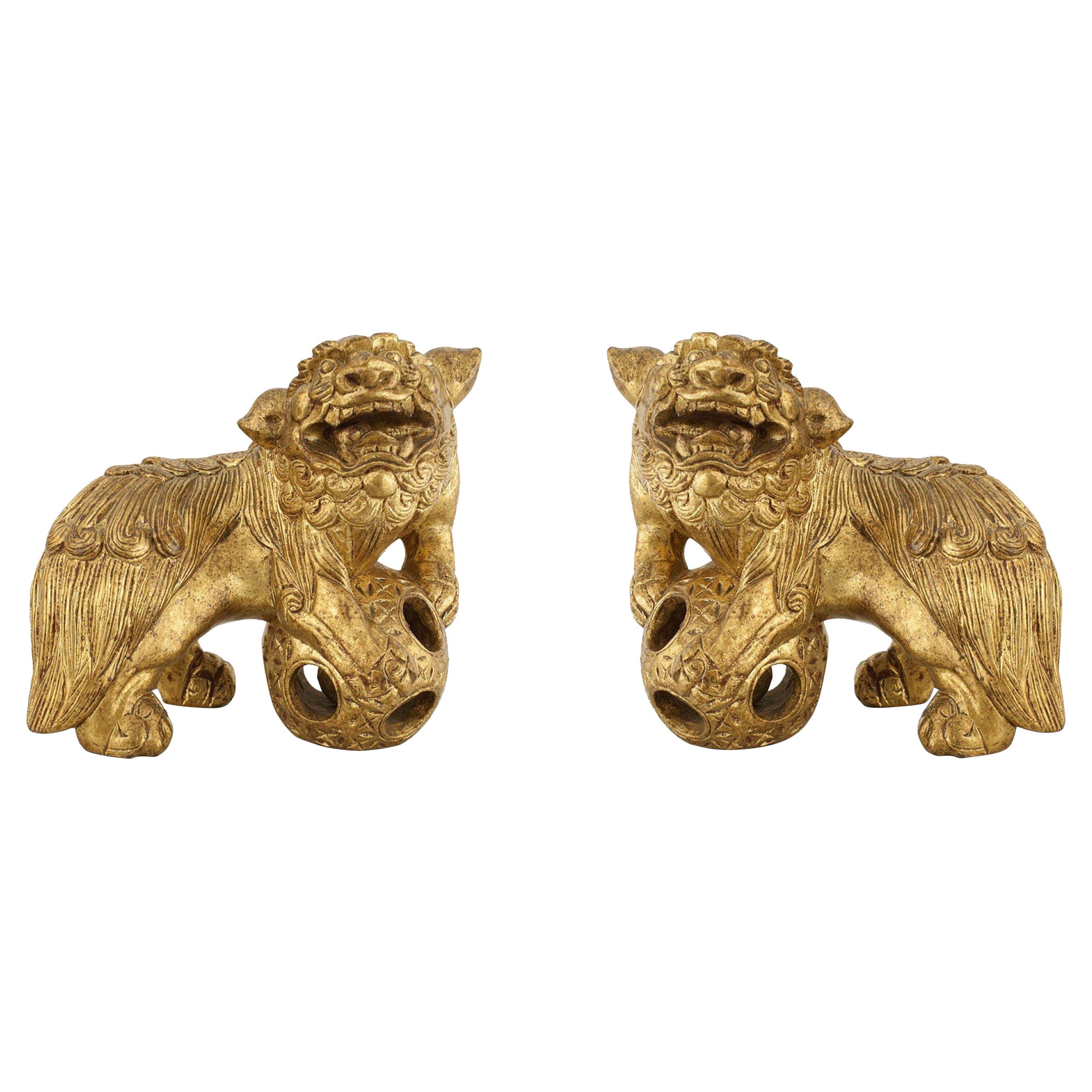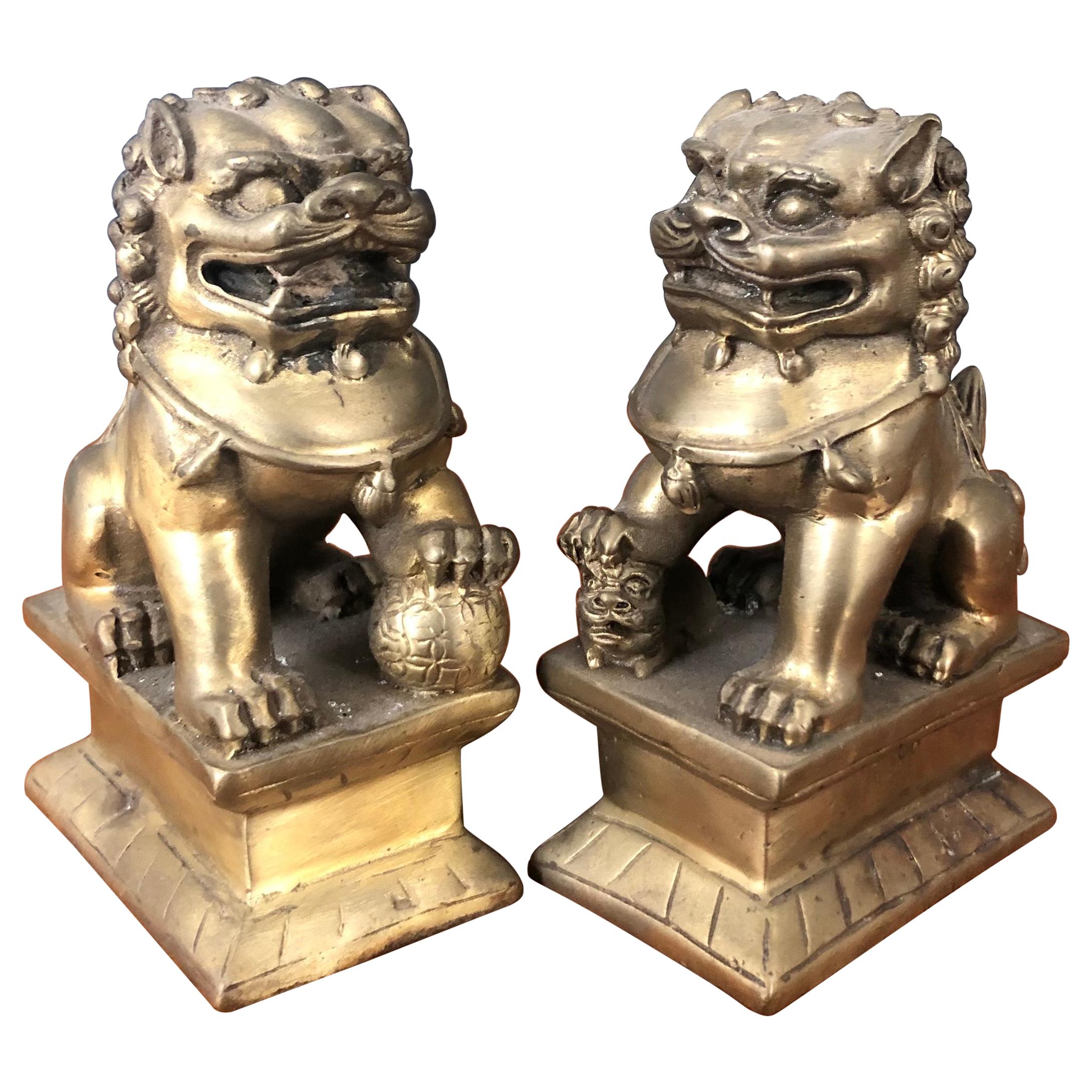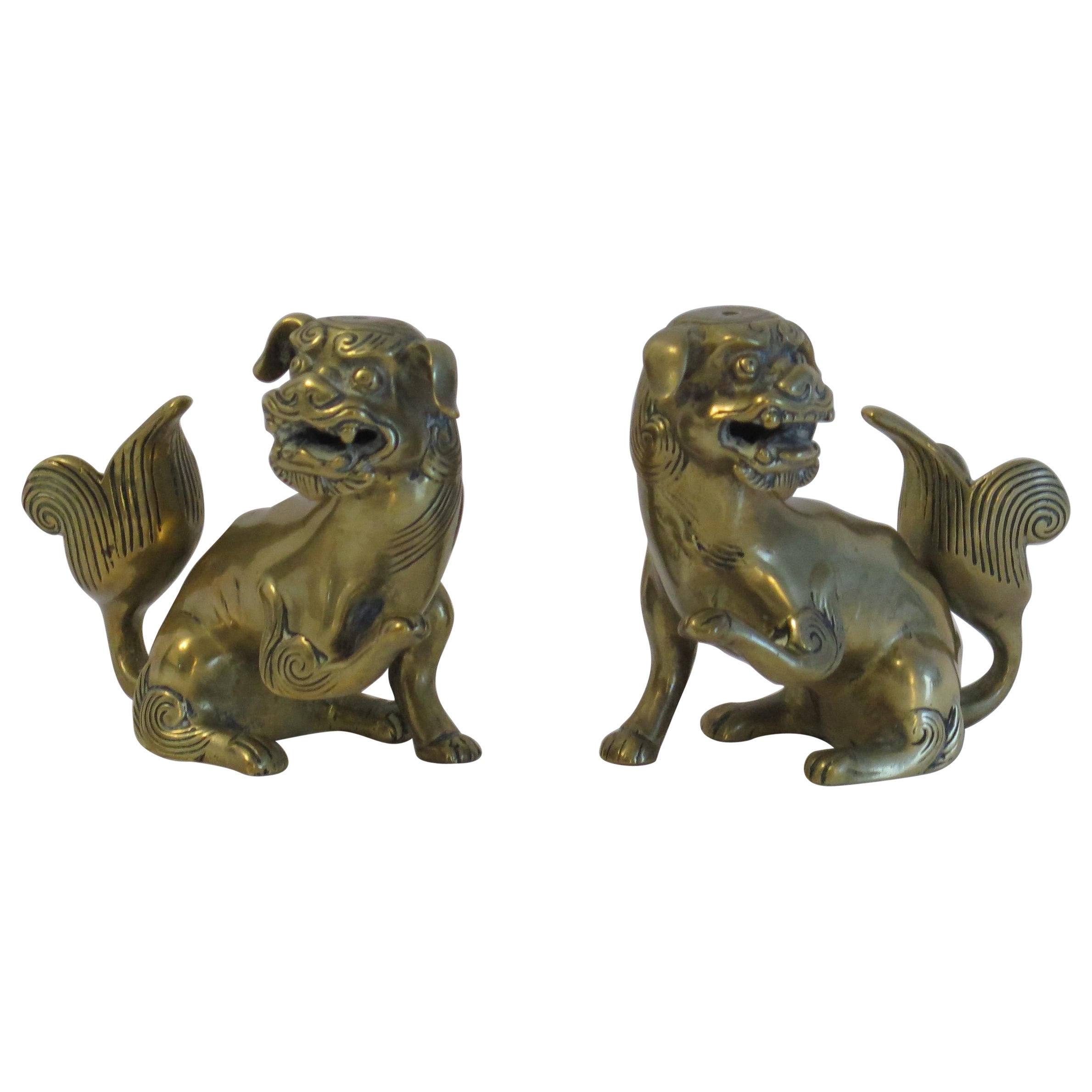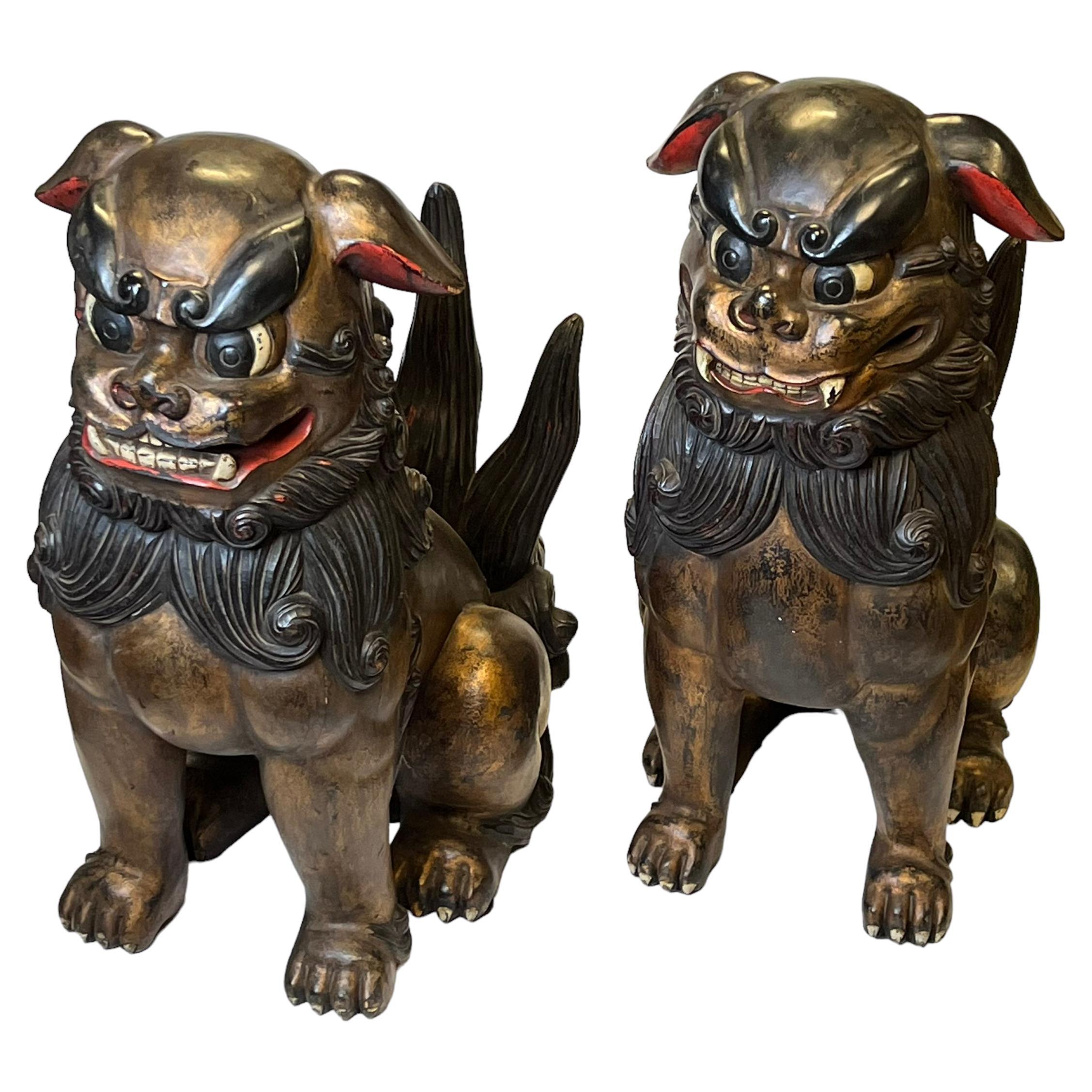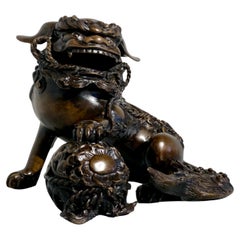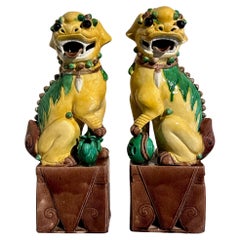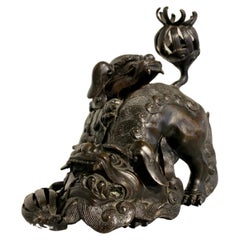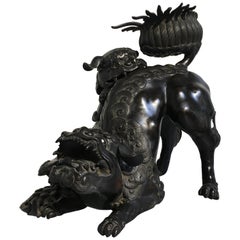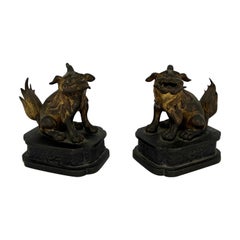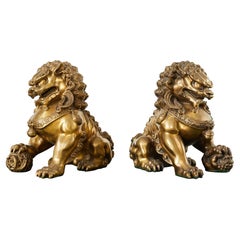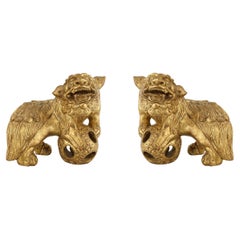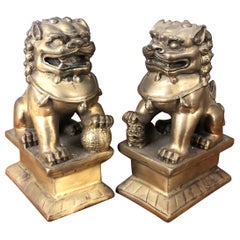Items Similar to Pair of Japanese Gilt Bronze Komainu by Ishikawa Komei, Meiji Period
Want more images or videos?
Request additional images or videos from the seller
1 of 11
Pair of Japanese Gilt Bronze Komainu by Ishikawa Komei, Meiji Period
$38,000per set
£28,854.30per set
€32,997.05per set
CA$53,091.51per set
A$59,049.35per set
CHF 30,833.74per set
MX$718,567.76per set
NOK 393,793.85per set
SEK 369,309.16per set
DKK 246,269.61per set
Shipping
Retrieving quote...The 1stDibs Promise:
Authenticity Guarantee,
Money-Back Guarantee,
24-Hour Cancellation
About the Item
A striking pair of Japanese gilt bronze komainu by the renowned Japanese sculptor, Ishikawa Komei (1852-1913), Meiji period, Japan.
The pair well cast, and robustly modeled. They are portrayed seated on their haunches, with broad, muscular chests, long, flowing manes, and a flame-like tails. The rich gilding further highlighting the strong musculature of these beasts. Their sharp faces, ending in wide, flattened ruyi shaped noses, and mouths set in almost mischievous grins.
Near mirror images, the figures differ only slightly. One lion has his ears pitched forward, and his mouth open, symbolizing the Sanskrit seed syllable "ah" ("a" in Japanese). The other lion has his ears standing upright, and his mouth closed, symbolizing the Sanskrit seed syllable "om" ("um" in Japanese). Together, these two sounds are said to encompass the entire universe, and are equivalent to the Greek "alpha" and "omega".
These lions are based on a pair, carved in wood and dating to the Kamakura period (1185-1333), that originally guarded the Taiho Shrine, Shiga Prefecture, and are now housed in the Kyoto National Museum.
Also known as karashishi, or simply shishi in Japan, in the west they are commonly referred to as foo dogs or foo lions. These ferocious creatures are considered guardians of sacred spaces, and are usually placed at the entrance to shrines or temples.
A nine character inscription in Chinese seal script has been cast to the underside of each lion, reading "Teishitsu gigeiin Ishikawa Komei" (Imperial Artist Ishikawa Komei).
Ishikawa Komei (1852 - 1913) was a renowned Meiji Period artist, known mostly for his carved works in ivory, though he worked across a wide spectrum of media, including bronze, plaster, and paint. Originally trained as a painter of the Kano school, he taught as a professor at the Tokyo School of Fine Arts, where a bust in his honor stands today. When the Imperial Artist system was implemented in 1891, Komei was one the first to receive the honored title. His bronze works are considered quite rare.
Provenance:
Peter Rosenberg / Vallin Galleries
Christie's New York, 2003
- Dimensions:Height: 13 in (33.02 cm)Width: 6 in (15.24 cm)Depth: 9.5 in (24.13 cm)
- Sold As:Set of 2
- Style:Meiji (Of the Period)
- Materials and Techniques:
- Place of Origin:
- Period:
- Date of Manufacture:after 1891
- Condition:Wear consistent with age and use. Minor rubbing to the gilt.
- Seller Location:Austin, TX
- Reference Number:1stDibs: LU89475162313
About the Seller
5.0
Platinum Seller
Premium sellers with a 4.7+ rating and 24-hour response times
Established in 2001
1stDibs seller since 2010
345 sales on 1stDibs
Typical response time: <1 hour
- ShippingRetrieving quote...Shipping from: Austin, TX
- Return Policy
Authenticity Guarantee
In the unlikely event there’s an issue with an item’s authenticity, contact us within 1 year for a full refund. DetailsMoney-Back Guarantee
If your item is not as described, is damaged in transit, or does not arrive, contact us within 7 days for a full refund. Details24-Hour Cancellation
You have a 24-hour grace period in which to reconsider your purchase, with no questions asked.Vetted Professional Sellers
Our world-class sellers must adhere to strict standards for service and quality, maintaining the integrity of our listings.Price-Match Guarantee
If you find that a seller listed the same item for a lower price elsewhere, we’ll match it.Trusted Global Delivery
Our best-in-class carrier network provides specialized shipping options worldwide, including custom delivery.More From This Seller
View AllJapanse Bronze Shishi Foo Lion by Shuzan / Hideyama, Meiji period, Japan
Located in Austin, TX
A heavy and powerfully cast Japanese bronze model of a shishi or foo lion by Hideyama / Shuzan, Meiji Period, circa 1900, Japan.
The dramatic lion, known as a shishi in Japan, is ca...
Category
Antique Early 1900s Japanese Meiji Animal Sculptures
Materials
Bronze
Pair Vintage Chinese Yellow Glazed Tall Foo Dogs, Mid 20th Century, China
Located in Austin, TX
A fun and colorful pair of vintage Chinese famille jaune glazed porcelain tall (15") foo dogs or foo lions, Chinese export, early to mid 20th century, China.
The delightful pair of ...
Category
Mid-20th Century Chinese Chinese Export Sculptures and Carvings
Materials
Enamel
Chinese Bronze Fighting Foo Lions Censer, Qing Dynasty, Late 19th Century, China
Located in Austin, TX
A fantastic Chinese cast bronze censer in the form of two Buddhistic lions play fighting, late Qing Dynasty, late 19th century, China.
The censer formed as a pair of Buddhistic li...
Category
Antique Early 1900s Chinese Qing Sculptures and Carvings
Materials
Bronze
Large Late Qing Dynasty Chinese Cast Bronze Buddhistic Foo Lion Censer
Located in Austin, TX
A large and powerfully cast Chinese bronze censer in the form of two Buddhistic lions, Qing dynasty, late 19th century. The censer is well cast with a strong sense of movement, featuring a pair of fierce Buddhistic lions playfully antagonizing each other. Locked in a mock battle, the smaller lion...
Category
Antique Late 19th Century Chinese Qing Sculptures and Carvings
Materials
Bronze
Pair of Japanese Edo Period Parcel-Gilt Bronze Dragon Vases, Early 19th Century
Located in Austin, TX
A pair of well cast and dramatic Japanese parcel gilt bronze dragon vases, Edo period, early 19th century. The heavy bronze vases of pear shape, each with a single writhing dragon cast in high relief...
Category
Antique Early 19th Century Japanese Edo Metalwork
Materials
Bronze
Pair Chinese Ming Dynasty Glazed Buddhist Lions and Attendants, 17th Century
Located in Austin, TX
A fantastic pair of large Chinese tileworks sancai glazed Buddhistic lions and attendants, late Ming Dynasty, first half of the 17th century, Shanxi, China. Presented on custom 20th century wood and lacquer table-form stands.
This pair of lions and attendants portray Buddhist lions...
Category
Antique Mid-17th Century Chinese Ming Sculptures and Carvings
Materials
Ceramic, Wood
You May Also Like
Pair, Ming Dynasty Gilt Bronze Diminutive Chinese Foo Dogs / Guardian Lions
Located in Atlanta, GA
Chinese, Ming Dynasty.
Pair, Ming Dynasty Gilt Bronze Diminutive Chinese Foo Dogs or Guardian Lions of extraordinary quality and casting. Procured from an important New York Collect...
Category
Antique 17th Century Chinese Chinese Export Animal Sculptures
Materials
Bronze
$5,596 Sale Price / set
20% Off
Pair of Chinese Bronzed Metal Buddhist Temple Foo Dogs Lions
Located in Rio Vista, CA
Spectacular pair of Chinese Buddhist guardian temple foo dogs or foo lions intricately crafted from bronzed metal. The lions are depicted sitting with one having a paw on a ball or o...
Category
20th Century Chinese Qing Sculptures and Carvings
Materials
Metal
Pair of Chinese Gilt Foo Dogs
Located in Queens, NY
PAIR of Asian Chinese style gilt carved foo dog figures holding a open design ball
Category
20th Century Chinese Chinese Export Figurative Sculptures
Materials
Giltwood
$1,500 / set
Pair of Small Patinated Bronze Chinese Foo Dogs
Located in San Diego, CA
Pair of small patinated bronze Chinese foo dogs, circa 1950s. Excellent vintage condition with amazing detail and a gorgeous patina. Each dog measures 4.25" high x 2.5" deep x 3.5" w...
Category
Mid-20th Century Chinese Sculptures and Carvings
Materials
Bronze
$460 Sale Price / set
20% Off
Antique PAIR of Chinese Bronze Foo Dogs good detail, Qing early 19th Century
Located in Lincoln, Lincolnshire
These are a very good PAIR of antique Chinese foo or lion dog sculptures, sometimes called temple lions, made of a brass-bronze metal alloy, with excellent detail, dating to the early 19th century, Qing period or possibly earlier back to the 18th century.
They are a male and female pair, the male with the slightly larger head. These pieces are very well cast with good detail and wear, showing a very good depth of colour. Both dogs have a small hole on the top of the head for incense to be placed.
Each piece weighs about 700gm unpacked
Overall a lovely pair of antique Chinese Foo Dogs...
Category
Antique 19th Century Chinese Qing Sculptures and Carvings
Materials
Bronze, Metal, Brass
Pair Very Large Chinese or Japanese Carved Wooden Fu Lions
Located in New York, NY
Pair highly stylized large Chinese or Japanese carved wooden guardian lions (fu lions or foo dogs), hand-painted with gilt highlights.
Category
Early 20th Century Chinese Chinoiserie Animal Sculptures
Materials
Wood
More Ways To Browse
Japanese Ivory
Sculpture Of Two Lions
Foo Lion
Pair Of Greek Sculptures
Antique Japanese Mirrors
Bronze And Ivory Sculpture
Japanese Lion
Ivory Carvings
Gold Mirror Asian
Antique Japanese Ivory
Meiji Bronze Sculptures
Face Plaster Sculpture
Pair Bronze Dogs
Carved Ivory Sculpture
19th Century Plaster Casts
Lion Bust
Imperial Lion
19th Century Japanese Wood Carving
